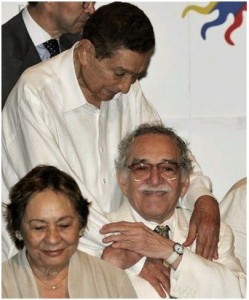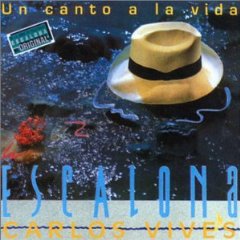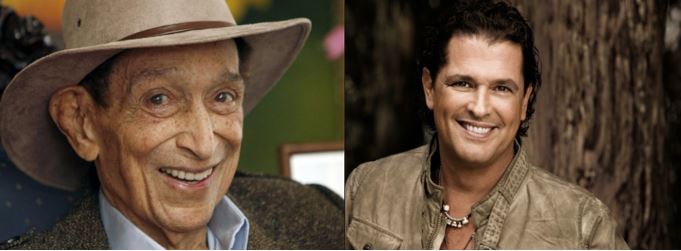This post is also available in:
 Español
Español
Rafael Escalona and Carlos Vives have been two of the main forces that popularized “vallenato” in the last few years. Their careers and lives are interrelated in more ways than one.
Rafael Escalona helped popularize the Colombian music genre of vallenato through his songs. He spread his songs by playing them in “parrandas” (parties featuring groups of people signing). Escalona also used his social and political connections to spread vallenato.

These connections helped Escalona launch a popular Vallenato festival. The festival is held at the heart of “vallenato country” in the small city of Valledupar. The city is in the northern part of Colombia.
Carlos Vives propelled his otherwise languishing career by popularizing Escalona’s songs and modernizing vallenato. He took it from the rural parts of Colombia to the country’s big-city nightclubs. Eventually, he would take vallenato to the whole world.
Rafael Escalona’s legacy: popularized Vallenato with his songs and social influence
With the death of Rafael Calixto Escalona Martinez, 81, vallenato lost one of its pillar composers and advocates. “El Maestro”, as Escalona was referred to, liked to sing at private gatherings with friends and women, being a well-known “parrandero“. Rafael Escalona liked to partly until the late hours drinking whiskey and rum.
He was not a professional singer and made a living mostly as a cotton farmer. This was alluded in the song “El Villanuevero“, contained in the Carlos Vives album “Escalona: Un Canto a la Vida”.
In the below video, Rafael Escalona explains why he doesn’t sing in public or for money.
Rafael Escalona became such a popular vallenato composer and “parrandero” that he made friends with some of Colombia’s high-profile personalities. For many years he was a good friend of Colombian Nobel Prize-winning novelist Gabriel Garcia Marquez. But his most fruitful connection was with the governor of the state “Department of Cesar”, Alfonso Lopez Michelsen, a former President of Colombia.
In the 1960s, Rafael Escalona used to sing in “Vallenato Parrandas” in the Governor’s mansion. He was able to influence him to start and sponsor an annual “Festival de la Leyenda Vallenata” (Vallenato Legends Festival). The festival, held in the city of Valledupar, helped popularized vallenato beyond “La Guajira” and across Colombia.
Carlos Vives Modernized and Popularized Vallenato
In the earlier parts of his career, Carlos Vives was a little-known ballad signer. Born in the coastal town of Santa Marta, he moved to Bogota when he was 12. There, he eventually became a “novelas” (soap opera) actor.
His big break came when he was chosen to play the lead role in a Colombian TV series about the life of Rafael Escalona. Carlos Vives’ performance of Escalona’s songs in the TV series got him great reviews. Additionally, the success of the TV series created an opportunity that Carlos Vives quickly recognized. He decided to change the direction of his musical career, and adopted “vallenato“.
To give vallenato his own touch, Vives added some elements of his early musical passion for rock, as well as some elements of other Caribbean rhythms. This resulted in a series of successful recordings, with a couple dedicated exclusively to the songs of Rafael Escalona. Although the recordings gained commercial success, some vallenato “purists” did not like the style.
Carlos Vives songs began to get played in Bogota’s nightclubs. Soon they spread to the rest of the country and later to the rest of the world.
Carlos Vives: “Escalona, Un Canto a La Vida”

The first Carlos Vives recording in the “vallenato” music genre was “Escalona; Un Canto a la Vida”. For this album, Vives selected the Rafael Escalona songs he had popularized in the TV Series.
This album made a few changes to the vallenato format, using trombones and other elements of Caribbean rhythms. The album was a success and he immediately followed it with “Escalona, Volumen 2”.
“Un Canto a la Vida” brings the essence of Rafael Escalona’s songs. These are mostly tales of events in Escalona’s life, or of people he knew. One song, “Jaime Molina”, is about his longtime friend who was a good painter. This was a profession that as a youngster Rafael Escalona wanted to follow. However, he found that his friend had more talent at drawing than he did, which that led him to discover he was a good poem writer. Eventually, his writing passion evolved to writing songs for the girls he liked.
In the video clip below of the “Escalona” TV series, Carlos Vives acts and sings the “Jaime Molina” as part of his death and funeral.
As an example, “La Patillalera” is about a woman in the town where Escalona was born, Patillal, Colombia. Carlos Vives performs flawlessly in the album, reflecting his passion for the music and bringing forward vallenato’s happiness and folk.
If you are new to vallenato music, this is a great album to kill two birds with one stone. You get a great Carlos Vives performance and a new style of vallenato which maintains its fun/happy essence but with a pop sound.
Modern or Traditional Vallenato?
Besides Carlos Vives, there are other great vallenato artists worth considering. Fonseca is a great Colombian talent that plays with a modernized vallenato style. On the other hand, Peter Manjarres (“Solo Clásicos”) brings a more traditional vallenato sound. Vallenato is a fun music genre, rich in storytelling lyrics and fun for dancing.
Who is your favorite vallenato artist? Do you prefer the more modern style of vallenato or do you prefer the more traditional sound? Share with us which ones you like and if you prefer the more modern or the more traditional style of vallenato.


I remember when I was a Kid a TV Show named “Escalona” it was a very popular “novela” and also the song that was very popular “Jaime Molina”. Those are my first encounter with Escalona.
[…] It turns out that the güira is used in other musical genres throughout Latin America. It’s used with the very same name in Colombia by certain bands of Cumbia and even Vallenato. […]
[…] are my favorite genres. However, I also write about Boleros, Latin Pop, Latin Rock, Reggaetón, Vallenato, Merengue, Tango, Ranchera, Trova, and just about any music from Latin America. (Note: check the […]